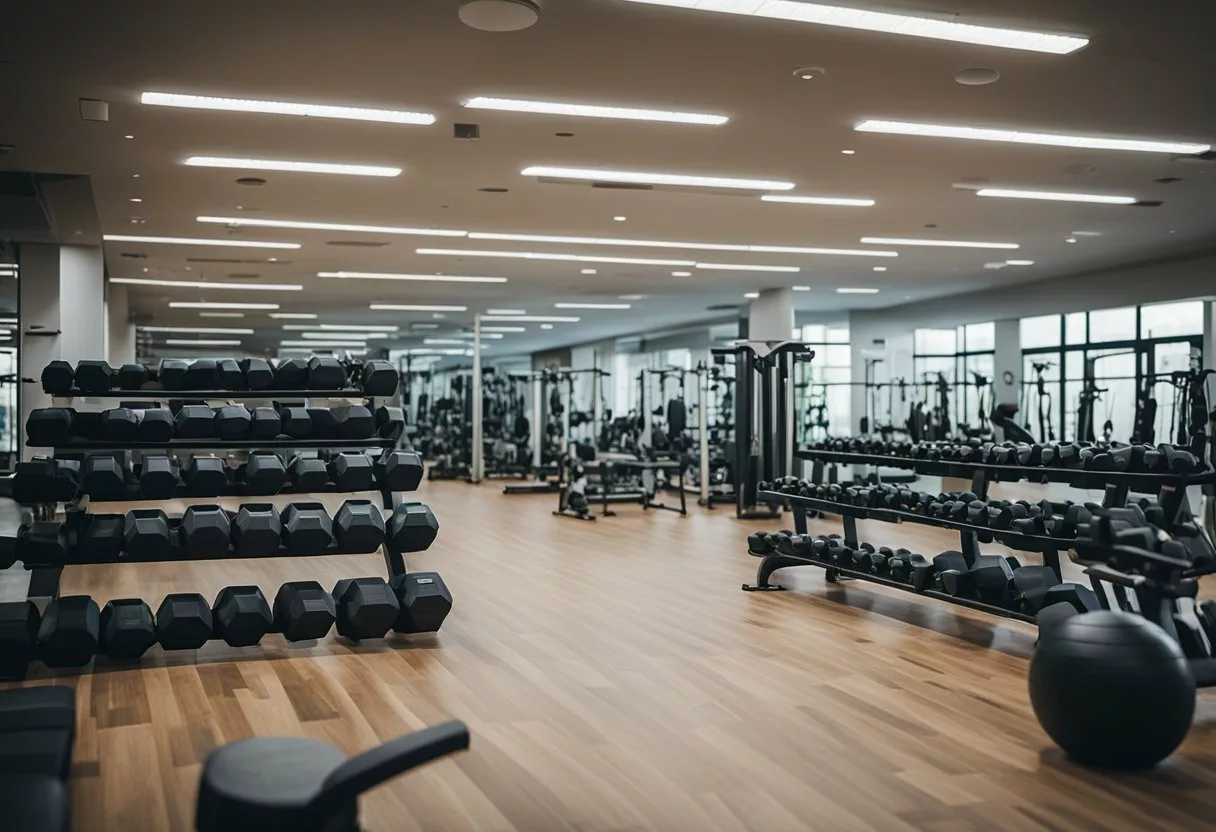As we age, maintaining muscle mass becomes increasingly important for overall health and longevity. After reaching their peak in the early 30s, muscle strength and mass begin to decline. Strength training can significantly improve muscle health, even in older adults. Incorporating resistance exercises into daily routines helps combat age-related muscle loss, known as sarcopenia.

Nutrition also plays a crucial role. Consuming a balanced diet rich in protein supports muscle maintenance and growth. Older adults should aim to include sources of lean protein, such as fish, poultry, and legumes, to sustain muscle health. Additionally, physical activity combined with proper nutrition can prevent and manage chronic diseases, enhancing quality of life.
Key Takeaways
- Strength training is vital for maintaining muscle mass as we age.
- A balanced diet with adequate protein supports muscle health.
- Regular exercise and good nutrition prevent chronic diseases.
Understanding Muscle Mass and Aging

As individuals age, muscle mass and strength tend to decline, which can lead to increased frailty and mobility issues. This section will explore the role of skeletal muscle in aging, the phenomenon of sarcopenia, and the physiological changes that contribute to muscle loss with age.
Role of Skeletal Muscle in Aging
Skeletal muscle plays a crucial role in maintaining overall health and physical function as we age. It supports mobility, balance, and metabolism. Muscle tissue is highly adaptive and responds to various stimuli, such as exercise and injury. Maintaining muscle mass helps prevent physical decline and reduces the risk of falls and injuries.
Lean muscle mass decreases significantly with age. By the ninth decade, individuals may lose up to 50% of their peak muscle mass. This reduction impacts mobility and increases the likelihood of disabilities. Optimal muscle status is essential for sustaining a high quality of life in older adults.
Sarcopenia and Muscle Mass Decline
Sarcopenia refers to the age-related loss of muscle mass and strength. This condition starts as early as the mid-life years and accelerates with advanced age. Sarcopenia is characterized not only by loss of muscle mass but also by a decline in muscle function, which can exacerbate frailty and reduce independence.
Preventing sarcopenia involves regular physical activity, particularly resistance and strength training. Adequate protein intake and nutritional support also play a significant role in mitigating muscle loss. Understanding the mechanisms of sarcopenia is key to developing strategies for intervention and management.
Physiology of Muscle Loss with Age
The physiology behind muscle loss with aging includes several factors. Muscle fibers shrink and reduce in number. The body’s ability to produce essential proteins for muscle repair and growth diminishes. Hormonal changes, like decreases in growth hormone and testosterone, contribute to reduced muscle mass.
Inflammation levels tend to rise with age, further affecting muscle health. Chronic diseases and sedentary lifestyles worsen muscle deterioration. Regular exercise and nutritional interventions help counteract these changes, supporting muscle maintenance. Researchers continue to study these physiological processes to find better ways to maintain muscle health in older adults.
The Impact of Nutrition on Muscle Mass

Proper nutrition plays a crucial role in maintaining muscle mass, especially as one ages. This includes adequate protein intake, essential amino acids, and strategies to combat anabolic resistance.
Protein Intake and Muscle Maintenance
Adequate protein intake is key to preserving muscle mass. The Recommended Dietary Allowance (RDA) for protein is 0.8 grams per kilogram of body weight daily. This amount supports basic health needs, but higher intake may benefit muscle preservation in older adults.
Muscle atrophy can impair physical function, so seniors might require more protein. This additional intake aids in maintaining muscle mass and strength, which are essential for daily activities. Dairy, meat, legumes, and fish are protein-rich foods that can help meet these needs.
For those who struggle to consume enough protein through diet alone, supplements can be a practical option to ensure adequate intake. Balanced meals containing varied protein sources are ideal for optimizing muscle health.
Amino Acids and Protein Synthesis
Amino acids, the building blocks of protein, are vital for muscle repair and growth. Essential amino acids must be obtained from the diet as the body cannot produce them. These are crucial for effective protein synthesis, which helps strengthen and repair muscle tissues.
Leucine, for example, plays a significant role in triggering muscle protein synthesis. Foods like whey protein, soy, and chicken are high in leucine. Ensuring sufficient intake of these foods can help support muscle growth and recovery, particularly after exercise.
A balanced diet rich in diverse protein sources can provide the necessary amino acids to support muscle health. Combining various foods maximizes amino acid intake, fostering better muscle maintenance and function.
Nutrition and Anabolic Resistance
Anabolic resistance refers to the reduced ability of older muscles to synthesize protein in response to nutrients and exercise. This condition makes it harder for older adults to maintain muscle mass, even with adequate protein intake.
To combat anabolic resistance, higher protein intake and regular exercise are recommended. Resistance training combined with protein-rich meals can enhance muscle protein synthesis, improving muscle health.
Certain nutrients, like omega-3 fatty acids, may also help reduce anabolic resistance. Fish oil supplements or foods like salmon and walnuts could be beneficial. Addressing anabolic resistance through a comprehensive nutrition and exercise plan is essential for maintaining muscle mass and promoting healthy aging.
Exercise and Physical Activity Essentials

Engaging in regular physical activity is crucial to maintaining muscle mass and promoting healthy aging. Key components include resistance training, cardiovascular exercises, and personalized activity plans for older adults.
Resistance Training Benefits
Resistance training helps maintain and build muscle mass. This type of exercise includes lifting weights, using resistance bands, and body-weight exercises like push-ups.
As people age, muscle loss can lead to weakness and reduced mobility. Resistance training improves muscle strength and endurance. It also helps in performing daily tasks, reducing the risk of falls. By engaging in resistance training, older adults can preserve muscle mass, enhance bone density, and maintain independence.
A common recommendation includes lifting 1-2 sets of 8-12 repetitions at moderate effort levels. This controlled approach ensures safety while maximizing benefits.
Cardiovascular and Endurance Exercises
Cardiovascular exercises are crucial for heart health and overall well-being. Activities like walking, swimming, and cycling increase heart rate and boost endurance.
These exercises help in maintaining a healthy weight, improving mood, and managing chronic diseases such as diabetes and hypertension. Regular participation in cardiovascular activities enhances stamina, making everyday tasks more manageable.
It’s suggested to aim for at least 150 minutes of moderate-intensity aerobic activity each week. Short, regular sessions are often more beneficial for older adults, promoting consistency and reducing the risk of injury.
Tailoring Physical Activity for the Elderly
Physical activity programs for older adults should be tailored to individual capabilities and health conditions. Customizing exercises ensures they are safe and effective.
Balance training is essential to prevent falls. Simple activities like standing on one leg or walking heel-to-toe can significantly improve stability.
It’s also important to consider any chronic conditions. Gentle stretching, flexibility exercises, and low-impact activities can benefit those with arthritis or joint pain.
Encouraging participation in group activities can provide social engagement and motivation. Adjustments in exercise intensity, frequency, and type ensure that physical activity remains a sustainable part of a healthy aging routine.
Preventing and Managing Chronic Diseases

Maintaining muscle mass can significantly impact the management and prevention of various chronic diseases. It is closely tied to conditions like type 2 diabetes and cardiovascular disease, and engaging in regular exercise plays a crucial role in this process.
Muscle Mass and Type 2 Diabetes
Muscle mass holds a key role in managing type 2 diabetes. Increased muscle mass improves insulin sensitivity, helping the body to use glucose more effectively. This reduces blood sugar levels and decreases the risk of developing type 2 diabetes.
Adequate muscle mass allows for better glucose metabolism. Individuals with greater muscle mass are less likely to experience insulin resistance, a major factor in type 2 diabetes. Including strength training as part of a regular exercise regimen can therefore be beneficial for those at risk of or managing type 2 diabetes.
Musculoskeletal Function and Cardiovascular Disease
Preserving musculoskeletal function is essential for preventing cardiovascular disease. Strong muscles, especially in older adults, can decrease the likelihood of physical limitations that lead to a sedentary lifestyle. Physical inactivity is a significant risk factor for cardiovascular disease.
Maintaining muscular fitness supports efficient heart and blood vessel function. It helps in managing blood pressure and cholesterol levels, both crucial in preventing heart diseases. Strength and endurance activities increase heart pumping efficiency, reducing stress on the heart and lowering the risk of complications.
Impact of Exercise on Chronic Disease Prevention
Regular exercise is paramount in the prevention of chronic diseases. Physical activity aids in maintaining a healthy weight, improving mental health, and enhancing overall physical condition. Engaging in at least 150 minutes of moderate-intensity activities like brisk walking, coupled with muscle-strengthening exercises, can offer significant health benefits.
Exercise reduces the risk of developing chronic diseases by improving cardiovascular health, enhancing muscle function, and boosting immune response. This holistic effect of regular physical activity underscores its importance in both the prevention and management of chronic conditions, promoting a healthier and more active life.
Strategies for Healthy Weight and Metabolism

Balancing calorie intake with physical activity, maintaining a balanced diet, and ensuring proper sleep can significantly impact metabolic health. These strategies help in managing weight and supporting a healthy metabolism.
Balancing Calories and Physical Activity
Managing weight involves balancing the calories consumed with those burned through physical activity. Regular exercise, such as three 15-minute walks per week, can aid in maintaining a healthy weight. Muscle-building exercises are also vital as they boost metabolism. It is important to choose activities that are enjoyable and can be consistently maintained. Tracking calorie intake using apps or food diaries can help in making mindful food choices.
Maintaining Metabolic Health Through Diet
Diet plays a critical role in metabolic health. One should aim to consume a variety of nutrients from fruits, vegetables, whole grains, and lean proteins. Drinking water and avoiding sugary drinks is essential for hydration and weight management. Eating enough protein is crucial as it supports muscle mass, which is a metabolically active tissue Muscle Mass and Longevity.
Influence of Sleep and Lifestyle on Metabolism
Adequate sleep and a healthy lifestyle are key to maintaining metabolic health. Poor sleep can disrupt hormones like insulin and cortisol, leading to weight gain and metabolic issues. Aim for 7-9 hours of sleep per night to support overall health. Additionally, managing stress through activities like meditation or yoga can help in maintaining a healthy metabolism. Avoiding smoking and limiting alcohol intake are also recommended.
These strategies combined can effectively support healthy weight and metabolism.
Community and Support Systems

In aging, being part of a community and having strong support systems can greatly enhance muscle health and overall well-being. These networks provide both emotional and physical benefits that are crucial as people get older.
The Role of Community in Aging
Communities play a significant role in helping older adults maintain their muscle health. Social interactions can encourage participation in physical activities, which are essential for muscle strength. Group exercise classes, walking clubs, and community sports leagues offer opportunities for physical activity and social engagement.
Being part of a community also reduces the feeling of isolation, which can negatively affect mental and physical health. Involvement in group activities can lead to better mental health, thereby indirectly improving physical health. Additionally, access to community resources like fitness centers and wellness programs provides older adults with the tools they need to stay active and healthy.
Support Systems for Physical Function
Support systems, including family, friends, and caregivers, are key in helping older adults maintain their physical function. They can assist with daily activities, remind individuals to follow their exercise routines, and provide encouragement.
Caregivers can also help monitor health changes and ensure that older adults are following medical advice related to nutrition and physical activity. Structured support systems like these can help prevent falls and injuries, which are common concerns for older adults.
Additionally, some communities offer specialized programs and services, such as transportation to fitness centers or personalized exercise plans to ensure that older adults have access to the tools they need for maintaining muscle health. These services are vital for those who may have mobility issues or limited access to facilities.
Integrating Supplements and Hormonal Support

Maintaining muscle health as people age involves incorporating dietary supplements and managing hormone levels. Effective strategies help preserve lean body mass and improve overall muscle function.
Role of Supplements in Muscle Health
Protein supplements support lean body mass by providing essential amino acids. Whey and casein proteins are popular options. They are quickly absorbed and help repair muscle tissue. BCAA (Branched-Chain Amino Acids) supplements also aid in muscle recovery and growth by reducing exercise-induced muscle damage.
Vitamin D is vital for muscle function. Low levels are linked to muscle weakness and higher fall risk in older adults. Omega-3 fatty acids can reduce inflammation and improve muscle strength. Adding these to the diet can have positive effects on muscle health.
Combining these supplements with regular exercise enhances their benefits. Physical activity increases muscle protein synthesis and optimizes the effectiveness of these dietary aids.
Testosterone and Muscle Maintenance
Testosterone plays a crucial role in maintaining muscle mass. Levels naturally decline with age, leading to increased fat and reduced lean body mass. Testosterone replacement therapy (TRT) can help mitigate these effects by promoting muscle growth and strength.
Studies indicate that maintaining adequate testosterone levels supports overall muscle health. Men experience improvements in muscle mass and physical performance with TRT.
It’s essential to consult healthcare providers before starting any hormonal therapy. Proper medical supervision ensures the treatment’s safety and effectiveness, minimizing potential risks associated with hormone use.
Addressing hormone levels along with dietary supplements provides a comprehensive approach to aging muscle health.
Frequently Asked Questions

This section addresses common concerns regarding muscle mass and aging, covering important vitamins, supplements, physiological changes, and the benefits of strength training.
What vitamin is known to prevent age-related muscle loss?
Vitamin D is known to help prevent age-related muscle loss. It assists in maintaining muscle function and strength. Sun exposure and certain foods like fatty fish and fortified dairy products can boost vitamin D levels. Supplements may also be recommended if levels are low.
Which supplements are beneficial for muscle building in seniors?
Protein supplements, such as whey protein, help build muscle in seniors. Creatine is another supplement that improves muscle mass and strength. Omega-3 fatty acids from fish oil can also reduce muscle loss. Consulting with a healthcare provider before starting any new supplement regimen is advised.
What are the physiological muscle changes that occur during aging?
Muscle mass and strength decline with age due to a reduction in muscle fibers and changes in muscle tissue. This process is called sarcopenia. Other changes include a decrease in motor units and less efficient protein synthesis, which contribute to weakened muscles.
What are the main benefits of strength training for older adults?
Strength training helps maintain muscle mass, enhance metabolism, and improve physical function and independence. It also aids in reducing the risk of falls, bettering bone density, and boosting overall quality of life. Consistent strength exercises can lead to significant health improvements.
How does sarcopenia affect aging, and what are its signs?
Sarcopenia, the progressive loss of muscle mass and strength, can impact mobility and physical function in older adults. Signs include decreased muscle size, weakness, and difficulty performing daily activities. It may lead to higher fall risk and reduced independence.
Can individuals over 70 years old effectively regain muscle mass?
Yes, individuals over 70 can regain muscle mass with proper exercise and nutrition. Resistance or strength training programs tailored to their capabilities can significantly improve muscle strength and size. Adequate protein intake also supports muscle growth in the elderly.
